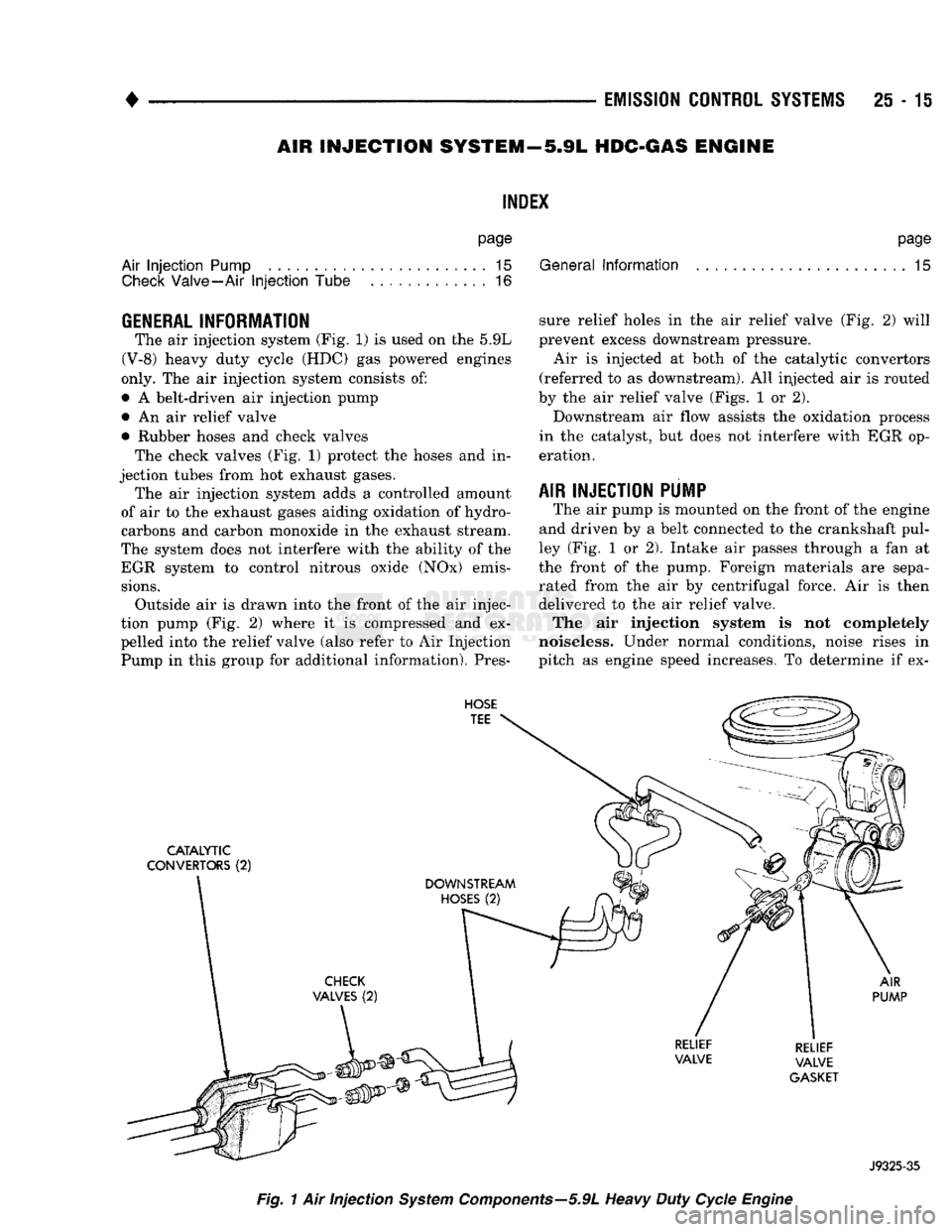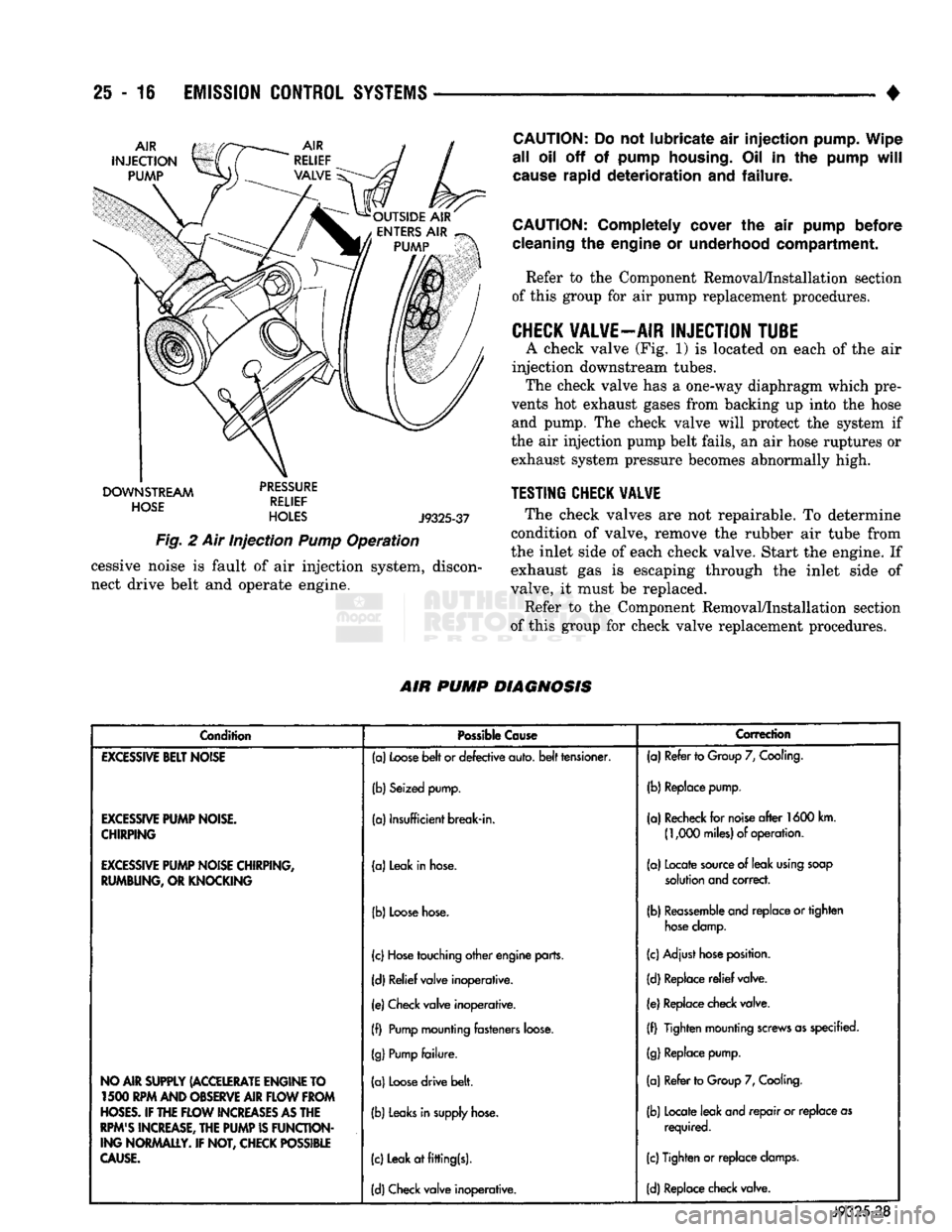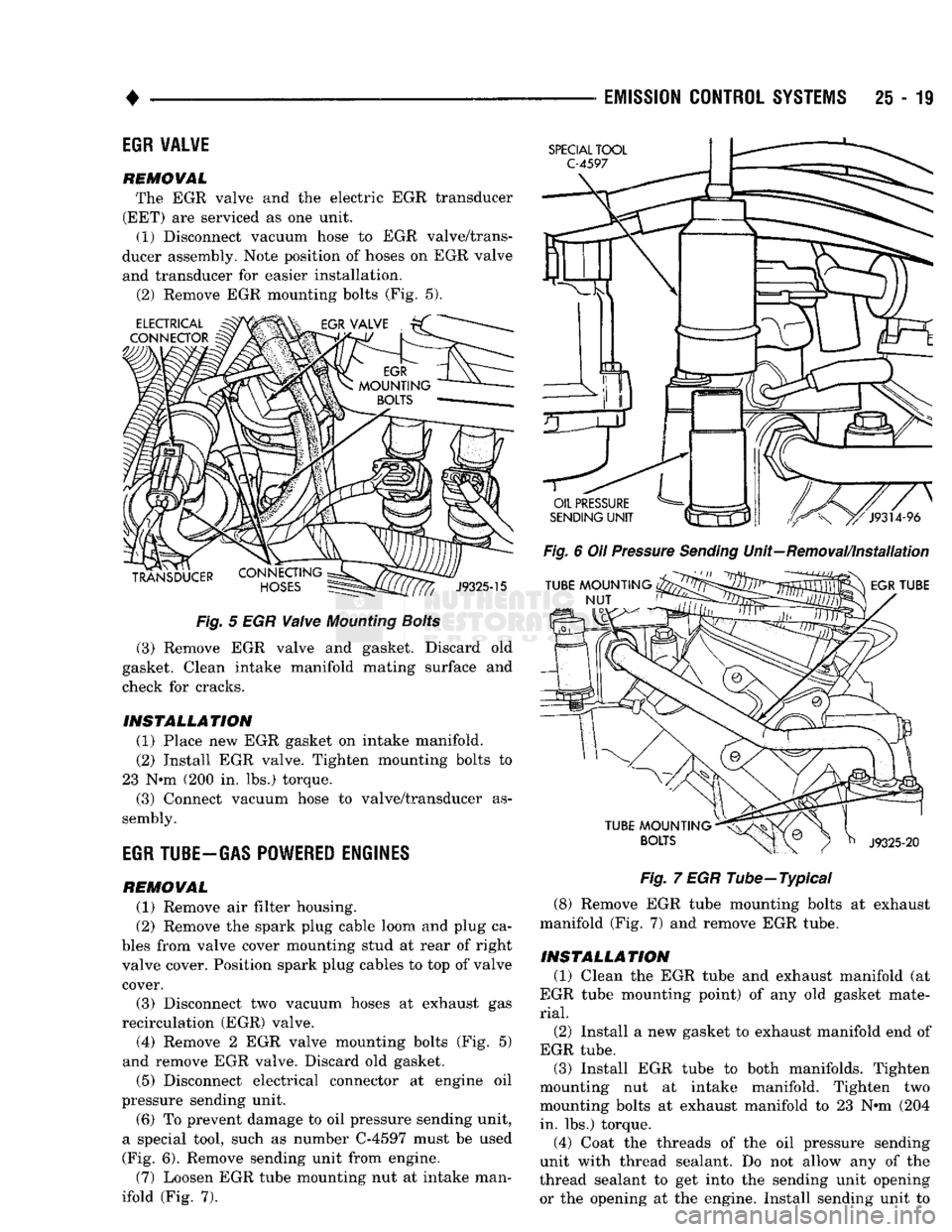1993 DODGE TRUCK check engine
[x] Cancel search: check enginePage 1489 of 1502

25
- 12
EMISSION
CONTROL
SYSTEMS
EGR
DIAGNOSIS
CHART
NOTE: ALL TESTS MUST BE MADE
WITH
FULLY
WARM ENGINE RUNNING CONTINUOUSLY FOR
AT
LEAST TWO MINUTES
WARNING: BE SURE
TO
APPLY PARKING BRAKE AND/OR BLOCK WHEELS BEFORE PERFORMING IDLE CHECK
OR
ADJUSTMENT,
OR ANY
ENGINE RUNNING TESTS
OR
ADJUSTMENTS.
Condition
Possible Cause
Correction
EGR
VALVE STEM
DOES
NOT MOVE
ON
SYSTEM
TEST.
(a) Cracked, leaking, disconnected or
plugged hoses.
EGR
VALVE STEM
DOES
NOT MOVE
ON
SYSTEM
TEST.
OPERATES
NORMALLY
ON EXTERNAL
VACUUM
SOURCE.
ENGINE
WILL
NOT
IDLE.
DIES OUT
ON
RETURN
TO
IDLE
OR
IDLE
IS
VERY ROUGH
OR SLOW.
(a) Defective control system—Plugged passages.
(b) Defective control system—solenoid or solenoid control circuit,
(a) High EGR valve leakage in closed
position.
(b) EGR tube to intake manifold leak.
(c) Solenoid or control signal to solenoid failure. (a)
(b)
(a)
(b)
(a) Verify correct hose connections and leak
check and confirm that alt hoses are open.
If defective hoses are found, replace hose
harness.
Disconnect hose harness from EGR vacuum
transducer and connect auxiliary vacuum supply. Raise engine rpm to 2000 rpm and hold. Apply 10" Hg vacuum while checking
valve movement. If no valve movement oc
curs,
replace valve/transducer assy. If valve
opens (approx. 3mm or 1/8" travel), hold
supply vacuum to check for diaphragm
leakage. Valve should remain open 30
seconds or longer. If leakage occurs, replace
valve/transducer assy. If valve is satisfac
tory, check control system. Remove throttle body and inspect port (slot
type) in throttle bore and associated passage in throttle body. Use suitable sol
vent to remove deposits and check for flow
with light air pressure. Normal operation
should be restored to EGR system. Refer to Group 14. General Diagnosis "On
Board Diagnostics" to check solenoid.
If removal of vacuum hose from EGR valve
does not correct rough idle,
(a
1)
Turn
engine off. Remove the air cleaner ex posing the inlet to the throttle body.
(a2) Disconnect the backpressure hose from the EGR valve.
(a3) Using a nozzle with a rubber grommet con nection, direct compressed air (50 to 60 psi)
down through the steel backpressure tube on
the EGR valve while opening and closing the
throttle blade.
(a4) If the sound from the compressed air changes distinctly in step a3, the poppet is leaking
and air is entering the intake manifold. Replace the EGR valve.
Remove tube and visually inspect tube seal
on gasket. Tube end should be uniformally
indented on gasket with no signs of leak. If
signs of exhaust gas leakage are present, replace gaskets and tighten flange nuts to
23 N-m (200 in. lbs.). If an intake plenum
leak persists, replace EGR tube and gaskets,
following installation instructions.
Verify correct hose connections and leak
check and confirm that all hoses are open. If defective hoses are found, replace nose
harness.
(cl) Refer to Group 14, General Diagnosis "On Board Diagnostics" to check solenoid. (b)
(c)
NOTE:
DO
NOT
ATTEMPT
TO CLEAN BACK-PRESSURE EGR VALVE, REPLACE
ENTIRE VALVE/TRANSDUCER ASSEMBLY
IF
NECESSARY.
9225-26
Page 1492 of 1502

•
EMISSION
CONTROL
SYSTEMS
25 - 15
AIR INJECTION SYSTEM—5.9L
HDC-GAS
ENGINE
INDEX
page
Air
Injection
Pump
15
Check
Valve—Air
Injection
Tube 16 General
Information
page
. . 15
GENERAL
INFORMATION
The air injection system (Fig. 1) is used on the 5.9L
(V-8) heavy duty cycle (HDC) gas powered engines
only. The air injection system consists of:
• A belt-driven air injection pump • An air relief valve
• Rubber hoses and check valves The check valves (Fig. 1) protect the hoses and in
jection tubes from hot exhaust gases. The air injection system adds a controlled amount
of air to the exhaust gases aiding oxidation of hydro
carbons and carbon monoxide in the exhaust stream.
The system does not interfere with the ability of the EGR system to control nitrous oxide (NOx) emis
sions.
Outside air is drawn into the front of the air injec
tion pump (Fig. 2) where it is compressed and ex
pelled into the relief valve (also refer to Air Injection Pump in this group for additional information). Pres sure relief holes in the air relief valve (Fig. 2) will
prevent excess downstream pressure.
Air is injected at both of the catalytic convertors
(referred to as downstream). All injected air is routed
by the air relief valve (Figs. 1 or 2).
Downstream air flow assists the oxidation process
in the catalyst, but does not interfere with EGR op eration.
AIR INJECTION PUMP
The air pump is mounted on the front of the engine
and driven by a belt connected to the crankshaft pul
ley (Fig. 1 or 2). Intake air passes through a fan at
the front of the pump. Foreign materials are sepa rated from the air by centrifugal force. Air is then
delivered to the air relief valve.
The air injection system is not completely
noiseless. Under normal conditions, noise rises in
pitch as engine speed increases. To determine if ex-
HOSE
TEE
CATALYTIC
CONVERTORS
(2)
AIR
PUMP
RELIEF
VALVE
GASKET
J9325-35
Fig.
1 Air injection
System
Components—5.9L
Heavy
Duty
Cycle
Engine
Page 1493 of 1502

25 - 16
EMISSION
CONTROL
SYSTEMS
•
DOWNSTREAM
dciicc
HOSE
RELIEF
HOLES
J9325-37
Fig.
2 Air Injection
Pump
Operation cessive noise is fault of air injection system, discon
nect drive belt and operate engine.
CAUTION:
Do not lubricate air injection pump. Wipe
all oil off of pump
housing.
Oil in the pump
will
cause
rapid deterioration and failure.
CAUTION:
Completely cover the air pump before
cleaning
the engine or underhood compartment. Refer to the Component Removal/Installation section
of this group for air pump replacement procedures.
CHECK
VALVE—AIR
INJECTION
TUBE
A check valve (Fig. 1) is located on each of the air
injection downstream tubes. The check valve has a one-way diaphragm which pre
vents hot exhaust gases from backing up into the hose and pump. The check valve will protect the system if
the air injection pump belt fails, an air hose ruptures or exhaust system pressure becomes abnormally high.
TESTING
CHECK
VALVE
The check valves are not repairable. To determine
condition of valve, remove the rubber air tube from
the inlet side of each check valve. Start the engine. If
exhaust gas is escaping through the inlet side of
valve, it must be replaced.
Refer to the Component Removal/Installation section
of this group for check valve replacement procedures.
AIR
PUMP
DIAGNOSIS
Condition
Possible
Cause
Correction
EXCESSIVE
BELT
NOISE
(a)
Loose
belt
or defective auto,
belt
tensioner. (a) Refer to
Group
7,
Cooling.
(b) Seized pump. (b) Replace pump.
EXCESSIVE
PUMP
NOISE.
CHIRPING
(a) Insufficient break-in.
(a) Recheck for
noise
after
1600 km.
(1,000
miles) of operation.
EXCESSIVE
PUMP
NOISE CHIRPING,
RUMBUNG, OR KNOCKING (a) Leak in
hose.
(a) Locate
source
of leak
using
soap
solution
and correct.
(b)
Loose
hose.
(b)
Reassemble
and replace or tighten
hose
clamp.
(c)
Hose
touching other engine parts. (c) Adjust
hose
position.
(d) Relief valve inoperative. (d) Replace
relief
valve.
(e) Check valve inoperative. (e) Replace check valve.
(f)
Pump
mounting fasteners
loose.
(f) Tighten mounting
screws
as specified.
(g)
Pump
failure.
(g)
Replace pump.
NO AIR SUPPLY (ACCELERATE ENGINE TO 1500 RPM AND OBSERVE AIR
FLOW
FROM
HOSES.
IF THE
FLOW
INCREASES
AS
THE
RPM'S
INCREASE, THE
PUMP
IS
FUNCTION
ING NORMALLY. IF NOT, CHECK POSSIBLE
CAUSE.
(a)
Loose
drive belt.
(b)
Leaks
in
supply
hose.
(c) Leak at fitting(s). (a) Refer to
Group
7,
Cooling.
(b) Locate leak and repair or replace as required.
(c) Tighten or replace
clamps.
(d) Check valve inoperative. (d) Replace check valve.
J9325-38
Page 1494 of 1502

•
EMISSION
CONTROL SYSTEMS
25 - 17
COMPONENT REMOVAL/INSTALLATION
INDEI
page
Air
Filter/Filter
Housing—Diesel Engines
17
Air
Filter/Filter
Housing—Gas Engines
17
Air
Injection
Pump
17
Air
Injection
Pump Relief Valve
18
Check
Valve—Air
Injection
Tube
18
Coolant Temperature
Sensor
. 18
EGR
Tube—Gas Powered Engines
19
EGR
Valve
19
AIR FILTER/FILTER HOUSING-GAS ENGINES
REMOVAL/INSTALLATION Remove crankcase breather/filter hose at side of air
filter housing. Remove wingnut (Fig. 1) and remove
housing from engine. Check condition of gasket at
throttle body and replace as necessary. To replace air filter element only: Remove wingnut
and air filter housing cover (Fig. 1). Clean inside of
housing before replacing filter. Housing removal is not necessary for filter replacement.
^
WING NUT
COVER
:
GASKET
| I
MOUNTING
STUD
Fig.
1 Air
Filter
Housing—Gas
Powered
Engines—Typical
page
Electric
EGR Transducer (EET)
20
EVAP
Canister
20
EVAP
Canister Purge Solenoid
20
Fuel Tank
Filler
Tube
Cap . 21
Oxygen
(02)
Sensor
21
Powertrain Control Module (PCM)
21
Pressure
Relief/Rollover Valve
21
If housing-to-throttle body mounting stud is being
installed, tighten to 10 N»m (90 in. lbs.) torque. In stall housing to engine and tighten wingnut to 1.5
N»m (15 in. lbs.) torque.
AIR FILTER/FILTER HOUSING-DIESEL ENGINES
REMO
VAL/INSTALLA
TION Remove the hose clamp at air filter housing (Fig.
2).
Remove mounting nuts and remove air filter
housing from vehicle.
To replace air filter element only: Remove hose clamp
and hose at air filter housing inlet tube. Remove three
wingnuts and air filter housing cover (Figs. 2 and 3). Clean inside of housing before replacing filter. Housing
removal is not necessary for filter replacement.
When installing a new air filter element, push el
ement into cover. Be sure it is pushed into tabs in
back of filter housing. Install wing nuts.
If housing had been removed, install mounting
nuts and tighten to 10 N»m (95 in. lbs.) torque.
AIR INJECTION PUMP
REMOVAL (1) Remove the relief valve hose clamp (Fig. 4) and
remove hose at relief valve.
(2) Remove relief valve from air pump (two bolts)
(Fig. 4). (3) Loosen (but do not remove at this time) the
three air pump pulley mounting bolts (number 2—figure 4).
(4) Relax the automatic belt tensioner and remove
the engine accessory drive belt. Refer to Group 7, Cooling System. See Belt Removal/Installation.
(5) Remove the three air pump pulley bolts and re
move pulley from pump.
(6) Remove the two air pump mounting bolts
(number
1—figure
4) and remove pump from mount
ing bracket.
Page 1496 of 1502

•
EMISSION
CONTROL SYSTEMS
25 - 19
EGR
VALVE
REMOVAL
The EGR valve and the electric EGR transducer
(EET) are serviced as one unit.
(1) Disconnect vacuum hose to EGR valve/trans
ducer assembly. Note position of hoses on EGR valve
and transducer for easier installation.
(2) Remove EGR mounting bolts (Fig. 5).
Fig.
5 EGR
Valve
Mounting
Bolts
(3) Remove EGR valve and gasket. Discard old
gasket. Clean intake manifold mating surface and
check for cracks.
INSTALLATION
(1) Place new EGR gasket on intake manifold. (2) Install EGR valve. Tighten mounting bolts to
23 N*m (200 in. lbs.) torque. (3) Connect vacuum hose to valve/transducer as
sembly.
EGR
TUBE-GAS POWERED ENGINES
REMOVAL
(1) Remove air filter housing.
(2) Remove the spark plug cable loom and plug ca
bles from valve cover mounting stud at rear of right
valve cover. Position spark plug cables to top of valve cover.
(3) Disconnect two vacuum hoses at exhaust gas
recirculation (EGR) valve. (4) Remove 2 EGR valve mounting bolts (Fig. 5)
and remove EGR valve. Discard old gasket.
(5) Disconnect electrical connector at engine oil
pressure sending unit.
(6) To prevent damage to oil pressure sending unit,
a special tool, such as number C-4597 must be used
(Fig. 6). Remove sending unit from engine.
(7) Loosen EGR tube mounting nut at intake man
ifold (Fig. 7).
Fig.
6 Oil
Pressure
Sending
Unit—Removal/Installation
Fig.
7 EGR Tube—Typical
(8) Remove EGR tube mounting bolts at exhaust
manifold (Fig. 7) and remove EGR tube.
INSTALLATION
(1) Clean the EGR tube and exhaust manifold (at
EGR tube mounting point) of any old gasket mate
rial.
(2)
Install a new gasket to exhaust manifold end of
EGR tube. (3) Install EGR tube to both manifolds. Tighten
mounting nut at intake manifold. Tighten two
mounting bolts at exhaust manifold to 23 N»m (204 in. lbs.) torque.
(4) Coat the threads of the oil pressure sending
unit with thread sealant. Do not allow any of the
thread sealant to get into the sending unit opening
or the opening at the engine. Install sending unit to